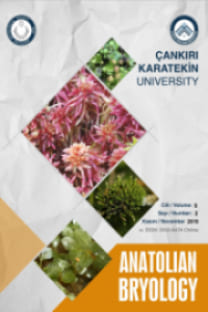Bazı Briyofitlerin Antimikrobiyal ve Antioksidan Aktiviteleri
Antimikrobiyal aktivite, Antioksidan aktivite, Disk difüzyon yöntemi, DPPH, Karayosunu
Antimicrobial and Antioxidant Activities of Some Mosses
Antimicrobial activity, Antioxidant activity, Disk diffusion method, DPPH, Moss,
___
- Altuner E.M. Canli K. Akata I. 2014. Antimicrobial screening of Calliergonella cuspidata, Dicranum polysetum and Hypnum cupressiforme. Journal of Pure and Applied Microbiology. 8:1, 539-545.
- Andrews J.M. 2007. BSAC standardized disc susceptibility testing method (version 6). Journal of Antimicrobial Chemotherapy. 60:1, 20-41.
- Asakawa Y. Ludwiczuk A. Nagashima F. 2013. Chemical constituents of bryophyta. Chemical Constituents of Bryophytes. Progress in the Chemistry of Organic Natural Products Vol. 95 Vienna: Springer. 563-605.
- Benek A. Şenturan M. Şimşek Ö. Canlı K. Altuner E.M. 2021. Bazı Karayosunu ve Ciğerotu Türlerinin Antimikrobiyal Aktivitesinin Belirlenmesi. Anatolian Bryology. 7:1, 1-7.
- Bozyel M.E. Şenturan M. Benek A. Merdamert Bozyel E. Canli K. Altuner E.M. 2019. In vitro antimicrobial activity screening of Heliotropium europaeum against wide range of microorganisms and multi drug resistant (MDR) bacteria. European Journal of Biomedical and Pharmaceutical Sciences. 6:3, 113-117.
- Canli K. Altuner E.M. Akata I. 2015. Antimicrobial screening of Mnium stellare. Bangladesh Journal of Pharmacology. 10:2, 321-25.
- Carranza M.S.S. Linis V.C. Ragasa C.Y. Tan M.C.S. 2019. Chemical constituents and antioxidant potentials of seven Philippine mosses. Malaysian Journal of Analytical Sciences. 23:6, 950-962.
- Chen F. Ludwiczuk A. Wei G. Chen X. Crandall-Stotler B. Bowman J.L. 2018. Terpenoid secondary metabolites in bryophytes: chemical diversity, biosynthesis and biological functions. Critical Reviews in Plant Sciences. 37:2-3, 210-231.
- Core R Team. 2016. R: A language and environment for statistical computing. R Foundation for Statistical Computing, Vienna, Austria. https://www.R-project.org/ [Erişim tarihi: 15/12/2017].
- Ertürk Ö. Sahin H. Ertürk E.Y. Hotaman H.E. Koz B. Özdemir Ö. 2015. The antimicrobial and antioxidant activities of extracts obtained from some moss species in Turkey. Herba Polonica. 61:4, 52-65.
- Ilhan S. Savaroğlu F. Çolak F. İşçen, C.F. Erdemgil F.Z. 2006. Antimicrobial activity of Palustriella commutata (Hedw.) ochyra extracts (Bryophyta). Turkish Journal of Biology. 30:3, 149-152.
- Krzaczkowski L. Wright M. Rebérioux D. Massiot G. Etiévant C. Gairin J.E. 2009. Pharmacological screening of bryophyte extracts that inhibit growth and induce abnormal phenotypes in human HeLa cancer cells. Fundamental & clinical pharmacology. 23:4, 473-482.
- Kürschner H. Frey W. 2020. Bryophyte novelties from the Arabian Peninsula and Socotra Island. Nova Hedwigia. 281-286.
- Mensor L.L. Menezes F.S. Leitão G.G. Reis A.S. Santos T.C.D. Coube C.S. Leitão S.G. 2001. Screening of Brazilian plant extracts for antioxidant activity by the use of DPPH free radical method. Phytotherapy research. 15:2, 127-130.
- Onbasli D. Yuvali G. 2021. In vitro medicinal potentials of Bryum capillare, a moss sample, from Turkey. Saudi Journal of Biological Sciences. 28:1, 478-483.
- Özen-Öztürk Ö. Özdemir T. Batan N. Erata H. 2023. Three Sphagnum taxa new to Turkey and South-West Asia. Botanica Serbica. 47:1, 47-53.
- Turu D. Bozyel M.E. Candan K. Yakan M.A. Benek A. Canli K. 2020. In vitro antimicrobial and antioxidant activities of Pyracantha coccinea fruits ethanol extract. Vitro. 4: 89-93.
- Uyar G. Doğru N.H. Ören M. Çavuş A. 2016. Determining Antibacterial Activity of Some Mosses (Cinclidotus riparius (Host ex Brid.) Arn., Calliergonella cuspidata (Hedw.) Loeske, Thamnobryum alopecurum (Hedw.) Gangulee, Leucobryum juniperoideum (Brid.) Müll. Hal., Cirriphyllum crassinervium (Taylor) Loeske & M. Fleisch.). Anatolian Bryology. 2:1-2, 1-8.
- Vollár M. Gyovai A. Szűcs P. Zupkó I. Marschall M. Csupor-Löffler B. Urbán E. 2018. Antiproliferative and antimicrobial activities of selected bryophytes. Molecules. 23:7, 1520.
- Whitehead J. Wittemann M. Cronberg N. 2018. Allelopathy in bryophytes-a review. Lindbergia. 41:1.
- Yayintas O. T. Ozyurt D. Demirata B. Yuceer Y.K. Yilmaz S. 2019. Chemical Composition and Antioxidant Capacities of Mosses Gathered from Mount Ida (Canakkale, Turkey). Fresenius Environmental Bulletin. 2413.
- ISSN: 2149-5920
- Yayın Aralığı: 2
- Başlangıç: 2015
- Yayıncı: Çankırı Karatekin Üniversitesi
Çevresel Radyoaktivite Çalışmalarında Biyoindikatör Karayosunları
Gomeda Vadisi (Kapadokya/Nevşehir) Epilitik Briyofit Vejetasyonu
Bazı Briyofitlerin Antimikrobiyal ve Antioksidan Aktiviteleri
Atakan BENEK, Kerem CANLI, Ergin Murat ALTUNER
Recep KARA, Hatice TAŞPINAR, Seda SERİN
Güncellenen Türkiye Briyofit Vejetasyonu Kontrol Listesi
Mevlüt ALATAŞ, Tülay EZER, Hüseyin ERATA, Nevzat BATAN
Kentsel Alandaki Epifitik Briyofit Birliği Orthotrichetum pumili Üzerine Notlar
